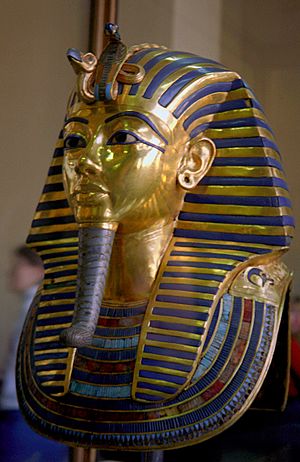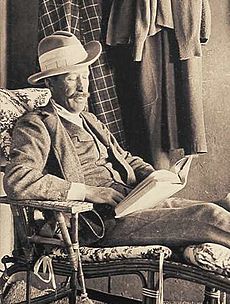Curse of the pharaohs facts for kids

The curse of the pharaohs is a famous idea. It's also called the mummy's curse. People believe it's a curse put on anyone who disturbs an ancient Egyptian mummy, especially a pharaoh's. This curse is said to bring bad luck, sickness, or even death. It doesn't matter if you are a thief or an archaeologist.
Since the mid-1900s, some people have tried to explain the curse using science. They suggest things like bacteria or radiation could be the cause. However, ancient Egyptians did sometimes write curses on tombs. These curses were usually meant to protect the tomb's purity. They were not usually warnings for robbers. Stories about curses became very popular after Howard Carter found the tomb of Tutankhamun. But it's important to know that no curse was actually written inside Tutankhamun's tomb.
Contents
Discovering Tutankhamun's Tomb
Many people started believing in a curse because some people linked to Howard Carter's team died. These deaths happened soon after the tomb was opened. Carter's team opened the tomb of Tutankhamun in 1922. This event started the modern study of Egyptology.
A famous Egyptologist named James Henry Breasted worked with Carter. He shared a story about Carter's messenger. The messenger heard a strange cry near Carter's house. He then saw a cobra in Carter's birdcage. The cobra, a symbol of Egyptian kings, had killed Carter's canary. This event made local rumors about a curse grow stronger.
Arthur Weigall, an expert in Egyptian history, also reported on this. He said people saw it as the Royal Cobra breaking into Carter's home. This happened on the same day the King's tomb was opened. The New York Times reported this story in December 1922.
The first death linked to the curse was Lord Carnarvon. He paid for the excavation. He was bitten by a mosquito. Later, he accidentally cut the bite while shaving. The cut became infected, leading to blood poisoning. He died on April 5, 1923.
Two weeks before Lord Carnarvon died, a writer named Marie Corelli wrote a letter. It was published in New York World magazine. She claimed that "terrible punishment" would follow anyone who entered a sealed tomb. This led to a media frenzy. News reports claimed a curse was found in the tomb, even though it wasn't true. Even Benito Mussolini, a leader who believed in superstitions, ordered an Egyptian mummy he owned to be removed from his palace.

Howard Carter himself did not believe in these curses. He said that Egyptologists feel respect and awe, not fear. He thought the curse stories were "foolish superstitions."
Many people who don't believe in the curse point out that most people involved lived long lives. A study looked at 58 people who were there when the tomb was opened. Only eight of them died within 12 years. The others lived much longer. Howard Carter himself died in 1939 at age 64, 17 years after the tomb was opened.
Lady Evelyn Herbert, Lord Carnarvon's daughter, was one of the first to enter the tomb. She lived for another 57 years and died in 1980. American archaeologist J.O. Kinnaman died in 1961, 39 years later.
Scientific Ideas About the Deaths
Some scientists have suggested that a fungus called Aspergillus flavus might have caused some deaths. This fungus can be toxic. It was linked to deaths after a tomb opening in Poland in 1973. Some think it might have affected Lord Carnarvon, George Jay Gould, and Arthur Cruttenden Mace. However, this link is still debated.
Deaths Linked to Tutankhamun's Curse
The tomb was opened on November 29, 1922. Here are some deaths people linked to the curse:
- George Herbert, 5th Earl of Carnarvon, died on April 5, 1923. He died from an infected mosquito bite. This was about four months after the tomb opened.
- George Jay Gould I, a visitor to the tomb, died on May 16, 1923. He developed a fever after his visit.
- A. C. Mace, a member of Carter's team, died in April 1928. He had suffered from lung problems for years.
- Captain The Hon. Richard Bethell, Carter's secretary, died on November 15, 1929.
- Howard Carter opened the tomb on February 16, 1923. He died much later, on March 2, 1939, at age 64. Even though he lived a long time, some people still blamed his death on the curse.
See also
- The Universal horror films The Mummy (1932), The Mummy's Hand (1940), and their sequels often talk about a curse.
- Pharaoh's Curse (1957 film)
- The Curse of the Mummy's Tomb (1964 film)
- The Curse of King Tut's Tomb (1980 film)


